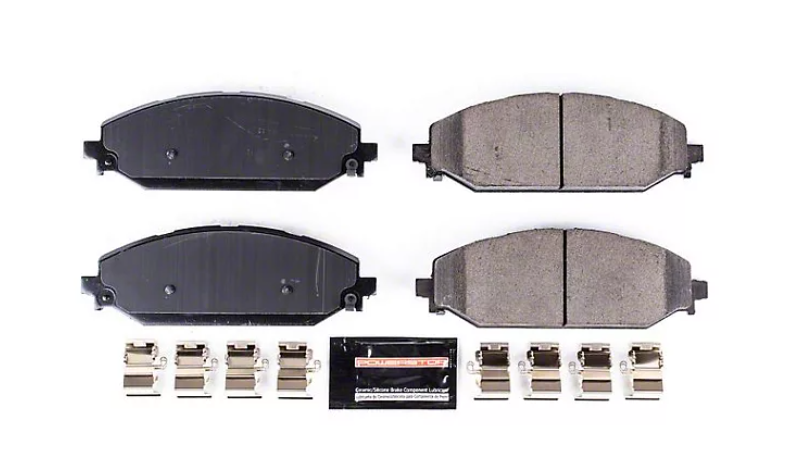
OEM Brake Pads vs Aftermarket Performance Pads: Which is Better?

By Mike Cote - December 3, 2018
It’s time to change your brake pads and you’re looking for the best option for your vehicle. But the choices seem endless. You want to buy the best brake pads, but you’re not exactly sure whether that’s sticking with OEM brake replacements or diving into forums and finding the best aftermarket brake pads for your make and model. Then, there’s the question of organic vs. ceramic vs. semi-metallic brake pads. It’s a lot, we get it.
OEM Brake Pads
Vehicle manufacturers choose their preferred type of stock or OE brake pads based on a number of reasons, including noise, dust, stopping ability, and wear. The ideal combination of these aspects is obviously low noise and dust, good stopping power – and a long pad life.
EBC Brake Pads
The Pros
- Produce less dust than traditional semi-metallic pads
- Allow for softer, quieter braking
- Work great upon immediate driving and in cold weather
- Cause less wear on your brake rotors than most performance aftermarket pads
The Cons
- Make for noticeably longer stopping distances
- Wear out sooner than most ceramic brake pads
- Can cause a “mushy” brake pedal feel
- Quickly lose their coefficient of friction under extreme heat
Since your car or truck was literally designed and manufactured with these brake pads in mind, getting OE replacement are an easy way to maintain the original driving and breaking experience of your car. And, for most drivers, they work just fine. But, while your OEM brake pads are engineered to meet the high level of performance necessary for 50,000 miles of stops, aftermarket brake pads exist for a reason.
Aftermarket Brake Pads
For people (and vehicles) that are spending a lot of time on dirt, off-roading, on the racetrack or have any number of adventurous ideas for their ride, quietly and efficiently putting up with the demands of your driving can be a lot to ask from an OEM brake pad. Especially since driving style, usage, and personal preferences are as varied as the vehicles on the road. This is when the best aftermarket brake pads will go a long way toward improving the performance and safety of your car or truck.
The Pros
- Made in a wide range of compounds, from organic to aramid fiber
- Less prone to brake fade when used with a high-performance brake fluid
- Dramatically shorter stopping distances over OEM pads
- Provide a more consistent pedal feel and better pedal modulation
The Cons
- Abrasive compounds will wear your brake rotors more quickly
- Must be heated to the optimal operating temp to brake effectively
- Produce more brake dust for more frequent cleaning
- Can be noisier than your OEM pads
And our gear junkies can rejoice because our selection of aftermarket pads really does cater to any driving style and make, model, and year. You can compare our favorite Power Stop brakes vs. your OEM parts, get those high-performance Brembo brakes your buddy mentioned or search a long list of top brands. They come in a wide range of compounds and will give you exactly what you need to be filled with pride every time you pump the brakes – whether that’s clean, quiet stops or massive amounts of bite.
The Second Question: Semi-Metallic vs. Ceramic Brake Pads?
Now that we’ve gone over the primary differences between your OEM brakes and performance pads, let’s get deeper into two of the most popular aftermarket types – semi-metallic and ceramic.
Posi Quiet Brake Pads
Semi-Metallic Brake Pads
Metal compound usually consists of steel, iron, and copper, combined with friction modifiers, fillers, and graphite lubricant. Metallic composition draws heat away from the rotor and aids in more efficient brake cooling. Produce more noise and dust than ceramic but are arguably the more versatile of the two. More effective over a wider range of temperatures and have a much higher thermal threshold. Provide better cold bite than ceramic pads and maintain much more consistent friction characteristics throughout their operating range. For track use or even spirited street driving, semi-metallic pads are the clear choice.
Ceramic Brake Pads
Composed of a dense ceramic material, similar to fired pottery, with embedded copper fibers. Generally cause less wear and tear on your rotors than semi-metallic pads. Less effective in cold weather or before the brakes are up to temperature. Typically have a lower coefficient of friction than their semi-metallic counterparts (the higher the coefficient of friction, the better a brake pad will stop your vehicle). Offer ample stopping power for casual city or highway driving.
Choosing OEM or Performance Brake Pads
Unfortunately, the question of OEM or aftermarket brake pads doesn’t have a simple, straightforward answer. For some, replacing your OEM brakes with a similar type pad is more than sufficient for your daily drive. But if you’ve decided to upgrade from OEM, the best aftermarket brake pads for your ride are really up to you. Ceramic pads offer quieter stops, cleaner wheels and generally longer pad life, while semi-metallic pads produce more noise and dust but are more effective over a wider range of temps. For even more help finding out what compromise is right for you, check out our comprehensive Brakes Buying Guide.